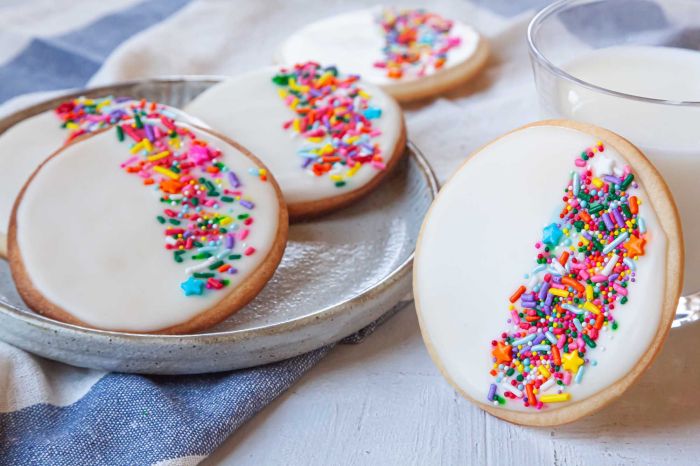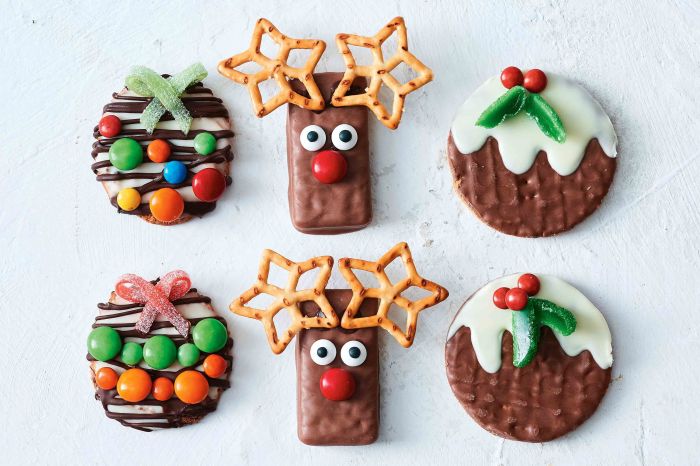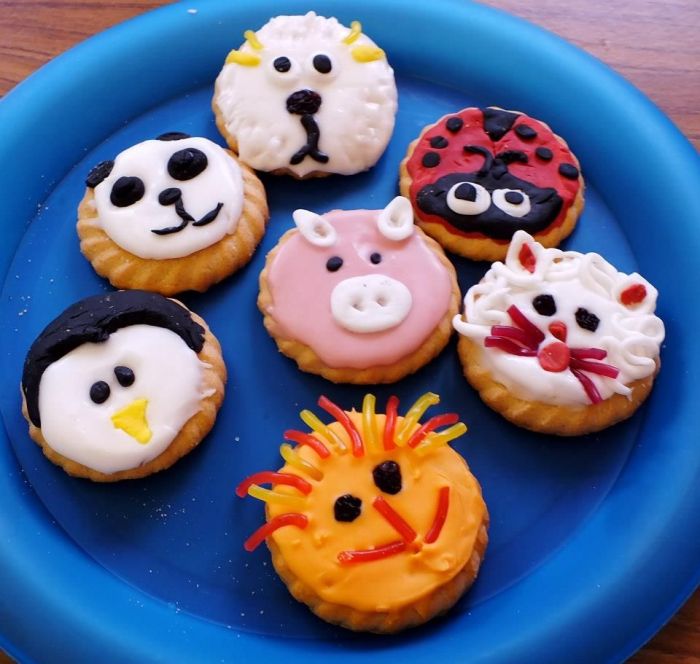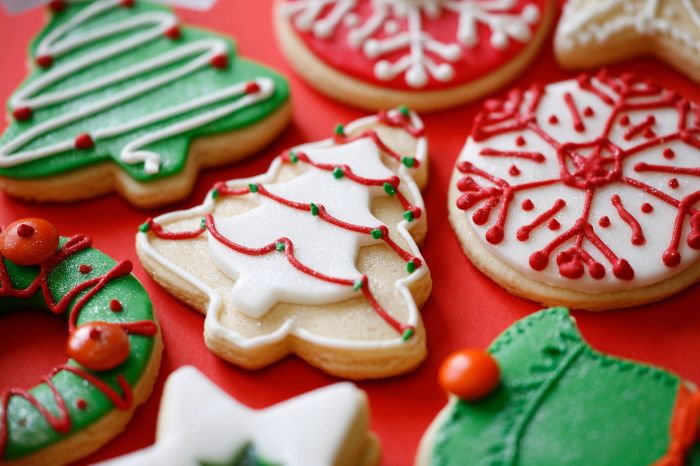Embark on a delightful journey into the world of biscuit decorating ideas, where creativity knows no bounds and your culinary canvas transforms into a symphony of edible art. From intricate royal icing designs to vibrant buttercream masterpieces, discover the secrets to elevating your biscuits from simple treats to stunning works of art.
Prepare to be inspired as we explore the vast array of decorating styles, color palettes, and techniques that will ignite your imagination and empower you to create delectable treats that will delight both the eyes and the taste buds.
Biscuit Decorating Styles

The art of biscuit decorating has evolved over the years, giving rise to a myriad of styles that cater to different tastes and skill levels. From the intricate precision of royal icing to the playful spontaneity of buttercream, each style offers a unique way to transform ordinary biscuits into edible masterpieces.
In this section, we will explore the diverse world of biscuit decorating styles, providing insights into their techniques, advantages, and suitability for various occasions.
Royal Icing
Royal icing is a versatile medium that allows for intricate designs and delicate details. Made from a combination of egg whites, powdered sugar, and flavoring, royal icing hardens into a smooth, glossy surface that can be piped into intricate patterns and shapes.
Royal icing is ideal for creating elegant and sophisticated designs, such as lacework, filigree, and fine lines. It is also well-suited for creating raised decorations, such as flowers, bows, and other three-dimensional elements.
Buttercream
Buttercream is a rich and creamy frosting made from butter, powdered sugar, and flavoring. Its smooth, spreadable consistency makes it easy to apply, creating a smooth and even finish.
Buttercream is a versatile frosting that can be used for a variety of decorating techniques, from simple swirls and borders to more elaborate designs. It is also well-suited for creating piped flowers and other three-dimensional decorations.
Fondant
Fondant is a pliable sugar paste that can be rolled out and draped over biscuits, creating a smooth and flawless finish. It is often used to create realistic-looking decorations, such as animals, flowers, and other intricate shapes.
Fondant requires some skill and patience to work with, but it offers a wide range of possibilities for creating stunning and eye-catching designs.
Painting, Biscuit decorating ideas
Painting is a less common but equally creative way to decorate biscuits. Using edible food coloring and fine brushes, artists can create intricate designs, patterns, and even portraits on the surface of biscuits.
Painting allows for a great deal of artistic freedom and expression, making it a suitable style for those who enjoy experimenting with different techniques and creating unique and personalized designs.
Color Palettes for Biscuit Decorating

When decorating biscuits, color plays a crucial role in creating visually appealing and mouthwatering treats. Understanding color theory and employing harmonious color combinations can elevate your biscuit designs and make them stand out.
Color theory involves the study of how colors interact, creating different effects and emotions. The color wheel is a fundamental tool in color theory, organizing colors based on their relationships. Primary colors (red, yellow, blue) cannot be created by mixing other colors, while secondary colors (green, orange, purple) are created by mixing primary colors.
Tertiary colors are created by mixing a primary and a secondary color.
Complementary Color Schemes
Complementary color schemes utilize colors opposite each other on the color wheel, creating a striking contrast. For example, red and green, blue and orange, or yellow and purple are complementary pairs. These combinations are vibrant and eye-catching, perfect for creating bold and festive designs.
Analogous Color Schemes
Analogous color schemes involve using colors adjacent to each other on the color wheel. They create a harmonious and cohesive look, as the colors naturally blend together. For instance, yellow, yellow-green, and green or blue, blue-violet, and violet are analogous combinations.
These schemes are suitable for creating subtle and elegant designs.
Triadic Color Schemes
Triadic color schemes utilize three colors equally spaced around the color wheel. They offer a vibrant and balanced look, creating a sense of movement and energy. For example, red, yellow, and blue or green, orange, and purple are triadic combinations.
These schemes are perfect for adding a pop of color to your biscuit designs.
Royal Icing Techniques

Royal icing is a versatile and edible medium used to decorate biscuits and other baked goods. It can be piped, flooded, or used in a variety of other techniques to create intricate and beautiful designs.
Some of the most common royal icing techniques include:
Piping
Piping is the technique of using a piping bag fitted with a decorating tip to create lines, dots, and other shapes on the surface of a biscuit.
- Piping can be used to create simple borders, intricate designs, or even 3D figures.
- The type of piping tip used will determine the shape and size of the piped design.
- Piping is a great way to add details and embellishments to biscuits.
Flooding
Flooding is the technique of using royal icing to fill in a designated area on the surface of a biscuit.
- Flooding can be used to create a smooth, even surface or to create a variety of textures.
- To flood an area, simply pipe a border around the area and then fill it in with royal icing.
- Flooding is a great way to create a solid base for other decorating techniques.
Wet-on-Wet
Wet-on-wet is a technique that involves applying royal icing to a surface that is still wet from a previous layer of icing.
- This technique can be used to create a variety of effects, such as marbling, swirls, and other patterns.
- Wet-on-wet is a great way to add depth and interest to your biscuit decorations.
- It is important to work quickly when using the wet-on-wet technique, as the icing will dry quickly.
Buttercream Frosting Techniques
Buttercream frosting is a staple in the world of cake decorating, known for its smooth, creamy texture and versatility. Three primary methods exist for creating buttercream frosting: American, Swiss, and Italian buttercream, each with unique characteristics and applications.
American Buttercream
American buttercream is the simplest and most common type, made by creaming together butter, powdered sugar, and milk or cream. Its ease of preparation and affordability make it a popular choice for home bakers. American buttercream has a light and fluffy texture, but it can be prone to curdling if not mixed properly.
Swiss Buttercream
Swiss buttercream is known for its silky-smooth texture and stability. It is made by whisking egg whites and sugar over a double boiler until stiff peaks form, then gradually incorporating butter. Swiss buttercream is more time-consuming to prepare than American buttercream, but it is less likely to curdle and holds its shape well, making it ideal for intricate piping and decorations.
Italian Buttercream
Italian buttercream is the most stable and firm of the three types. It is made by cooking a sugar syrup to a specific temperature, then gradually pouring it into whipped egg whites. Italian buttercream has a glossy, satiny finish and is highly resistant to melting, making it suitable for warm climates or elaborate cakes that require intricate details.
Fondant Techniques

Fondant, a pliable sugar paste, offers endless possibilities for biscuit decoration. Mastering its techniques unlocks a world of intricate designs and elegant embellishments.
Rolling and Cutting
Roll out fondant thinly using a rolling pin and dusting it with cornstarch or powdered sugar to prevent sticking. Use sharp cutters to create shapes and designs.
Molding and Shaping
Mold fondant into various forms using molds or your hands. Create realistic figurines, flowers, or abstract shapes by shaping and manipulating the paste.
Modeling
Use modeling tools and fondant glue to construct three-dimensional figures. Combine different colors and shapes to create intricate and eye-catching designs.
Drying and Hardening
Allow fondant decorations to dry at room temperature or use a fan to speed up the process. Fondant hardens over time, creating durable and stable decorations.
Edible Decorations for Biscuits
Edible decorations are a great way to add some extra flair to your biscuits. They can be used to create a variety of designs, from simple sprinkles to intricate piped designs.
Here is a list of some of the most popular edible decorations for biscuits:
- Sprinkles
- Candies
- Edible glitter
- Fondant
- Royal icing
- Buttercream frosting
When choosing edible decorations for your biscuits, it is important to consider the flavor and texture of the biscuit. You also want to make sure that the decorations will not overwhelm the biscuit.
If you are new to decorating biscuits, it is a good idea to start with simple designs. Once you have mastered the basics, you can start to experiment with more complex designs.
Biscuit Decorating Tools
When it comes to biscuit decorating, the right tools can make all the difference. From piping bags and tips to spatulas and brushes, having the essential tools on hand will help you create beautiful and professional-looking biscuits.
Here’s a comprehensive list of essential biscuit decorating tools:
Piping Bags
- Disposable piping bags are the most convenient and affordable option.
- Reusable piping bags are more durable and environmentally friendly, but they require more cleaning and maintenance.
- Choose the right size piping bag for the job. A small bag is ideal for intricate details, while a large bag is better for flooding or piping large areas.
Piping Tips
- Piping tips come in a variety of shapes and sizes, each designed for a specific purpose.
- Round tips are used for piping lines, dots, and circles.
- Star tips are used for piping stars, shells, and other decorative shapes.
- Leaf tips are used for piping leaves and other plant-like designs.
- Choose the right piping tip for the desired effect.
Spatulas
- Spatulas are used for spreading frosting, smoothing icing, and scraping bowls.
- Offset spatulas are ideal for spreading frosting on flat surfaces, while angled spatulas are better for getting into corners and crevices.
- Choose a spatula with a flexible blade for easy spreading.
Brushes
- Brushes are used for painting on details, blending colors, and creating texture.
- Choose a brush with soft bristles that won’t damage the frosting.
- Use a small brush for fine details and a larger brush for covering larger areas.
Biscuit Decorating for Special Occasions

Celebrate special moments with delectable biscuit decorations! Let your creativity soar as you adorn these delectable treats for holidays, birthdays, and weddings.
Holidays
- Deck the halls with festive biscuits shaped like Christmas trees, snowmen, and gingerbread men.
- Ring in the new year with glittery biscuits adorned with gold and silver sprinkles.
- Create spooky treats for Halloween with black and orange biscuits shaped like bats and pumpkins.
Birthdays
- Surprise your loved ones with personalized biscuits decorated with their names or favorite colors.
- Create an elegant birthday cake by stacking biscuits and frosting them with a gradient effect.
- Add a touch of whimsy with biscuits shaped like animals or cartoon characters.
Weddings
- Craft exquisite biscuits adorned with lace and floral patterns for a romantic touch.
- Create sophisticated biscuits in monochromatic hues for a chic and elegant affair.
- Surprise guests with heart-shaped biscuits decorated with intricate sugar flowers.
Biscuit Decorating Tutorials: Biscuit Decorating Ideas
Unlock the secrets of exquisite biscuit artistry with our comprehensive collection of step-by-step tutorials. Dive into a world of intricate designs and techniques, empowering you to transform your biscuits into edible masterpieces.
From royal icing filigree to buttercream swirls and fondant sculpting, our tutorials will guide you through every step, empowering you to create breathtakingly beautiful biscuits that will impress family and friends alike.
Royal Icing Techniques
- Outlining:Master the art of outlining with steady hands and precise brushstrokes, creating the foundation for intricate designs.
- Flooding:Fill in Artikeld areas with smooth, even layers of icing, creating a seamless canvas for further embellishments.
- Piping:Explore various piping tips to create borders, flowers, and other intricate details, adding depth and dimension to your designs.
- Wet-on-wet technique:Experiment with the fluidity of royal icing, allowing it to spread and create unique patterns and textures.
Buttercream Frosting Techniques
- Smooth frosting:Achieve a perfectly smooth finish with a spatula or offset palette knife, creating a flawless base for further decoration.
- Swirls and rosettes:Master the art of creating elegant swirls and rosettes with a piping bag, adding a touch of sophistication to your biscuits.
- Borders:Pipe intricate borders around the edges of your biscuits, framing your designs and adding a touch of elegance.
- Textured frosting:Experiment with different piping tips and techniques to create unique textures, adding visual interest to your biscuits.
Biscuit Decorating Inspiration Gallery
Prepare to be mesmerized by our gallery of exquisite biscuit decorations! We present a kaleidoscope of ideas and techniques that will ignite your creativity and inspire you to create edible masterpieces.Immerse yourself in the vibrant world of biscuit decorating, where imagination knows no bounds.
From intricate royal icing designs to whimsical fondant sculptures, our gallery showcases the limitless possibilities of transforming simple biscuits into edible works of art.
Visual Inspiration
[detailed content here]
- Showcase a curated collection of visually stunning biscuit decorations.
- Highlight the diversity of styles, from classic to contemporary.
- Include close-up images to showcase intricate details and techniques.
- Provide captions with brief descriptions of each decoration.
Techniques in Action
[detailed content here]
- Feature videos or animated GIFs that demonstrate specific decorating techniques.
- Showcase the step-by-step process of creating complex designs.
- Include voiceovers or text overlays to provide clear instructions.
- Offer tips and tricks for achieving professional-looking results.
Ending Remarks
Whether you’re a seasoned baker or just starting your sweet adventure, this comprehensive guide to biscuit decorating ideas will equip you with the knowledge, inspiration, and techniques to turn your biscuits into edible masterpieces that will impress and enchant.
So gather your ingredients, unleash your creativity, and let’s embark on a delightful journey into the world of biscuit decorating.
Q&A
What is the best type of icing for biscuit decorating?
Royal icing is a popular choice for intricate designs due to its ability to harden and create a smooth, glossy finish.
How do I achieve vibrant colors in my biscuit decorations?
Use high-quality food coloring gels or powders and experiment with mixing different colors to create unique hues.
What are some edible decorations I can use to enhance my biscuits?
Sprinkles, candies, edible glitter, and fondant shapes can add a touch of whimsy and elegance to your creations.


